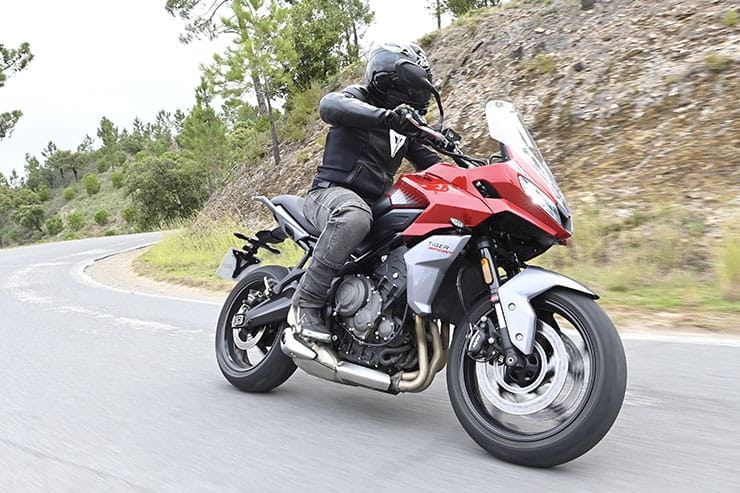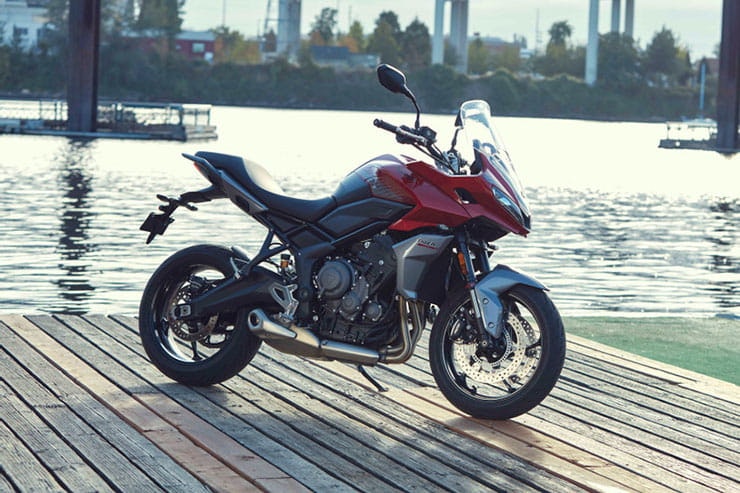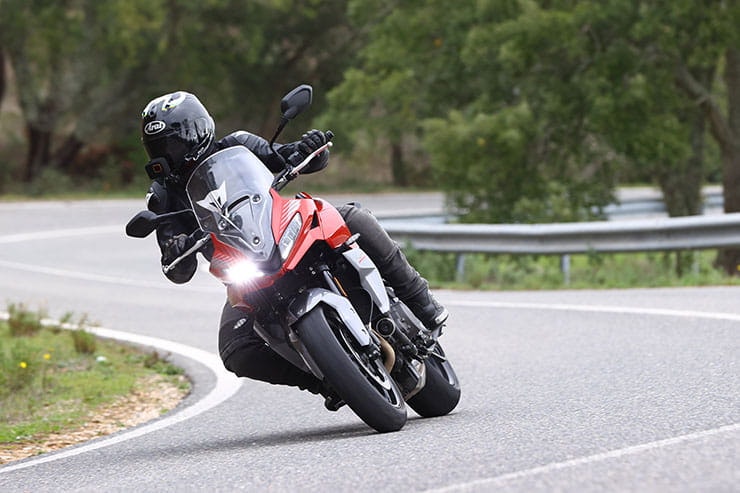Triumph Tiger Sport 660 (2022) - Review
By Arno Jaspers
Motorcycle Journalist
28.02.2022
Triumph’s Tiger 660 Sport is venturing into the hotly contested mid-range touring bike market. The brand builds on the 660 Trident platform by adding a modern top fairing, adjustable windscreen, wider handlebars and more everyday comfort with plush suspension. When compared to the Japanese competition, the Triumph stands out with its electronic features, impressive build quality and finish.
The boys from Hinckley don’t beat around the bush: the A2-licence friendly middleweight Tiger 660 Sport has to make short work of the Japanese competitors that have dominated this class for years. So they’ve built an agile yet comfortable middleweight sports tourer that’s appealing to both beginners and experienced riders alike… for a very reasonable price. Alongside the beautiful new Tiger Sport logo we see well-known names such as Nissin and Showa while one look at new dashboard shows off a basic electronics package - a first for this class if we exclude Aprilia's much more expensive 660 Tuareg.
Just like the rest of the Tiger range, this 660 offers a lot of comfortable touring pleasure, but it can handle some serious sporty riding as well. The Michelin Road 5 tyres provide excellent grip in all conditions while the front end is much sharper than you would expect from any bike in this segment. Combined with the grunty three-pot engine, this bike truly is the Street Triple ‘ST’ Triumph never built… which might leave some more experienced riders begging for a 765-version. When scrolling through the accessory range, we would definitely go for a set of heated grips, panniers and a quick shifter. We got to test the Korosi Red and Graphite version which together with the Lucerne Blue and Graphite and Black variants, will be available at your local dealership in February 2022.
Omicron scared us off from the international press launch in Portugal, so we enlisted Belgium’s finest in Arno Jaspers from MaxxMoto to offer his thoughts.
Amazing finish and build quality
Lovely three-cylinder engine
Standard equipment on point
Vibrations in the handlebars around the 5k rpm mark, unfortunately that’s where you’ll be at when riding highway speeds.
£100 premium for a colour way. Really?
This little mile muncher is begging for cruise control, heated grips and a centre stand
2022 Triumph Tiger Sport 660 preview
Take a closer look at the new Triumph Tiger Sport 660 as Michael Mann quizzes Miles Perkins, Triumph’s Head of Brand Management
Triumph Tiger 660 Sport Price
How much is the 2022 Triumph Tiger 660 Sport? From £8,450 and available in Korosi Red and Graphite, Lucerne Blue, Graphite and Black, from February 2022.
And here’s a sample PCP deal:
Power and torque
80bhp might not seem like a lot, but that’s 8 horses up on the Tracer 7 and 12 on the Versys 650. Not to mention the super linear torque curve which peaks at 64 Nm @ 6.250 rpm. After a very dynamic ride in Portugal, we can tell you that engine performance is not an issue on this bike, that will happily take you, your passenger and luggage over any Alpine pass without hesitation.
Engine, gearbox, and exhaust
Triumph's 660 three-cylinder is a reworked version of the 675 three-cylinder that we know from older Street Triples or the Daytona. The engine was given a shorter stroke, which reduced the displacement, and the power now peaks at 81hp @ 10,250 rpm. But more importantly the three-pot continues to amaze with its linear torque curve that peaks at 64 Nm @ 6,250 rpm. For 2022 this engine meets the Euro5 standard and the short underswept exhaust produces a muffled, but still very beautiful sounding triple soundtrack. To finish it off, the gearbox is definitely up to Japanese standards with a very smooth action and short ratios. As you would expect from a bike in this category, the clutch feels very light, although an adjustable clutch lever would be a valuable addition for riders with small hands. For more dynamic riding pleasure, you can always add the up/down quick shifter from the accessory-range for £229.
Handling, suspension, and weight
Don’t worry about the 206 kg curb weight. While that might seem rather heavy for a 660cc triple, the bike feels light and it simply excels with its agile and sharp front end.
The wide handlebars offer ideal leverage to deal with the tightest twisties, while high speed mid-corner stability is never an issue. Although the suspension setting is clearly aimed at comfortable touring - and therefore quite softly damped, this bike never shies away from sporty cornering action. During hard braking, the front dives a little too much for my liking, although I'm happy to assume the bike’s target audience won’t be as ‘enthusiastic’ with their encounters. At the rear, the spring preload is adjustable, which is a valuable extra for heavier riders or tourists with full panniers.
Triumph Tiger 660 Sport (2022) Comfort and economy
As far as comfort is concerned, I can be brief: this bike offers everything you would expect from a mid-range tourer with a spacious seating position. The windscreen offers good protection with a very practical adjustment system. Just pull it up or push it down with the big lever in the middle. The rather soft suspension only benefits comfort and there is also a roomy passenger seat with well-positioned footrests. On the winding Portuguese roads, following TT-racer Joe Ackroyd we noted a fuel consumption of 5,1l/100km (55.4mpg), so we’re pretty sure that with a little effort we can beat the claimed 4,5l/100km (62.8mpg).
Brakes
Twin Nissin two-piston callipers with 310mm discs and ABS, with a 255mm disc and single-piston rear wheel. That sounds like a modest brake setup, but in reality the direct bite might even be a bit too fierce for novice riders. So there is certainly no shortage of braking power. The ABS intervenes fairly quickly, especially in combination with the excellent grip of the Michelin Road 5 tires on the warm Portuguese asphalt. As I already mentioned, a TT racer as guide rider definitely helps to push the brakes to their limits a little faster than usual…
Rider aids, extra equipment, and accessories
Triumph has made serious progress in the field of electronics in recent years and for this mid-range Tiger the developers came up with a simple but very complete package with, above all, very intuitive operation. Six buttons on the left half of the handlebars are enough to navigate between two rider modes (Rain & Road), a traction control that can be switched off, and the usual dashboard information such as tripmeters, an odometer, gear indicator and consumption meter. A nice added extra is that you can easily switch in between dashboard layouts. E.g. a touring layout with tripmeters, fuel consumption etc. or one for sporty riding with nothing but a gear indicator, tach- and speedometer. Needless to say, the LCD-screen on the Tracer 7 never looked more outdated. A pannier set (£495), heated grips (£205) and handguards (£105) are the first things I would order from the 40-strong official accessories-catalogue, in addition to a paddock stand and bobbins (because there’s no centre stand) which handy for chain maintenance. Possibly also the up/down quickshifter for extra riding pleasure.
2022 Triumph Tiger Sport 660 Rivals
The competition is mainly in the Japanese corner with Yamaha's Tracer 7 and Kawasaki's Versys 650 followed by more All-road oriented bikes with a larger front wheel such as the Suzuki V-Strom 650, Honda's CB500X or even the BMW F 750 GS. The utmost price-conscious buyers might want to look at the CFMOTO 650 MT. Just don’t park it next to the Tiger.
Here’s a high-level comparison chart:
2022 Triumph Tiger Sport 660 - UK road test
That’s a lot of good-looking bike for £8450
The simple answer is ‘Yes you probably should buy a Triumph Tiger 660’. If you’re thinking about a bike like this and the idea of a bike with a smart balance of just enough power, more-than-enough acceleration, light weight, easy-to manage and affordable by 2022 standards, go try one…now.
For one thing it looks lovely. I’m still not sold on the neo-classic styling of the Trident 660 – a bike that doesn’t quite know what it wants to be – but the Tiger Sport is spot-on. Making a practical all-rounder look cool is a challenge that many bike stylists seem to struggle with. The Tiger looks funky and modern without straying into cartoon weirdness. It has the right number of headlights in the right places, a screen that works properly, a 17-litre fuel tank and sleek back end with the number plate where you’d expect it to be. From any angle it looks great. They’ve even managed to make a Euro-5 compliant exhaust that doesn’t block out the sun or need an additional catalyst bolted on the side like an afterthought.
High bars, low foot pegs and plenty of room to wiggle on the (very) long rider portion of the seat equals lots of comfort. Pillions are more comfy than you’d expect.
The riding position puts your arms and legs in the right places for control in corners and long-distance comfort. You’re upright enough to be comfortable, but with the screen in its lowest position there’s also enough windblast on your chest to prevent the lower back aches that some adventure bikes can give.
This isn’t an adventure bike. Or should that be it has no off-road pretensions. You can certainly have adventures on it, especially if your definition of adventure is adding 8mph to your average speed on a long and difficult journey you do on a regular basis.
I was genuinely shocked at how quickly I covered the ground on this bike. The reason appears to be that the Triumph’s speedo is deadly accurate. Most bikes (and in 27 years’ road testing I’ve ridden an awful lot of bikes) have a speedo that over-reads by around ten percent. So, you sit at an indicated seventy-and-a-bit assuming you are doing 70mph. Doing the same on the Tiger 660 knocks 15 minutes off a journey that normally takes 150, which makes it 8.4mph quicker than usual. It also explains why the fuel consumption at 53mpg was also about ten per cent higher than the high-50s mpg I was expecting.
So, if you buy a Tiger, take care through speed cameras and even more care through average speed cameras – there doesn’t appear to be much of a safety margin.
Well-developed motor has smart choice of gear ratios to make 83bhp feel like much more
The three-cylinder engine feels livelier than it’s claimed 83bhp. Partly because it revs much faster than its twin-cylinder rivals but also because Triumph chose the gear ratios carefully to give strong acceleration rather than an academic top speed that no one uses.
The rear sprocket is enormous making first gear almost redundant. Setting off in second gear is a doddle, which is handy because the gearchange on our test bike was a bit stiff and going down the gears approaching a junction sometimes left it in second when you were expecting first.
The lower gears make the most of that enormous sprocket for sharp acceleration, helped by equally sharp throttle response (it feels a lot sharper than the Trident 660 I rode last summer). Fifth and sixth gears are taller and more relaxed allowing relatively lazy cruising. And don’t forget that when on most bikes we say ‘80mph comes up at 6000rpm’ we mean an indicated 80mph, which is actually about 70mph. On the Tiger 660 that indicated 80mph is an actual 80mph.
Screen is easy to adjust, noisy in all positions, but there’s no buffeting. Speedo is more accurate than most
Some testers have complained about the Tiger being a bit vibey at motorway speed. I did a couple of 150-mile motorway trips and didn’t have any issues with vibes. I did leave a couple of van drivers looking grumpy though. The Tiger is a slim bike, and the handlebars are narrower than most adventure bikes. However, the mirrors (which offer a half-decent view behind) stick out an inch or so further than the bars. Thankfully, they are taller than most car wing mirrors, but this puts them exactly in the same spot as a Transit van’s mirrors.
So, the Tiger handles the commuting and long-distance bits of the all-rounder brief easily. What about the bits where we find the twistiest back road possible and ‘let’s see what this Baby will do…etc’? What it does is everything you’d expect a great road bike to do without any surprises or scares. That acceleration we talked about earlier gets rid of the dawdling tin-tops stuck behind the cyclists, the brakes are strong enough to give you options approaching a corner slightly too quickly and the simple chassis and basic-but-well set-up suspension put some ‘Cor’ into cornering.
Suspension is soft-but controlled in corners, remote preload adjustment is a nice touch at this price. Winter testing in the UK rarely troubles the edges of tyres. Roll-on summer.
The suspension feels soft for a sports bike but there’s no high-speed weaves and, although the front dives sharply when you hit the brakes, it takes a lot to make it bottom out, by which time the ABS has kicked in to wipe your metaphorical, er, nose.
That’s the 852 words on the good bits, is there anything that needs improving? I can’t think of much. The clocks and displays are a bit messy and fussy to use. There’s a lot of information and connectivity available in a very compact unit, but it takes a while to find the information you want, the menu buttons on the left handlebar aren’t backlit and while you can set-up your own display with just the info you want, it’s fussy and unintuitive. Oh, and I finally spotted the switch for the hazard lights (underneath the rhs switchgear) as the man from Triumph was loading it back into the van.
Apart from that (which is a road tester’s grumble because if it were your bike, you’d spend an afternoon setting up the display you want), there’s not a lot to grumble about. Checking the oil level with a dipstick rather than a sight-glass seems a little archaic, but other than that, I’m struggling to find things I didn’t like.
And yes, to go back to the top of this UK test, the simple answer is ‘if you are thinking about buying a Triumph Tiger 660, you almost certainly made the right decision.’ It’s one of those bikes that gets pretty much everything right without making any headlines.
Like we said at the top, it’s a good-looking bike that rides well for a good price. Hard to fault.
Triumph Tiger 660 Sport (2022) Verdict
The Tiger 660 Sport is a very valuable addition to an already packed middleweight segment. Based on the specs you would say this is a perfect everyday workhorse, but the agile chassis and lovely three-cylinder really give this bike an exciting edge over the competition. Added to that, there’s a basic electronics suite, good wind protection, a lot of riding comfort and that brilliant Triumph finish. At £8450 this Tiger 660 Sport offers great value for money, especially when considering the 10,000 miles/12 months service intervals.
Heated grips would be a handy addition here in the UK but for some markets it’s not warranted. That said, adding a few popular options in as standard such as the quickshifter and hand guards is soon going to push the price up.
Triumph Tiger 660 Sport (2022) Technical Specification
Photos: Kingdom Creative (G. Harford / D. Wood)
What is MCIA Secured?
MCIA Secured gives bike buyers the chance to see just how much work a manufacturer has put into making their new investment as resistant to theft as possible.
As we all know, the more security you use, the less chance there is of your bike being stolen. In fact, based on research by Bennetts, using a disc lock makes your machine three times less likely to be stolen, while heavy duty kit can make it less likely to be stolen than a car. For reviews of the best security products, click here.
MCIA Secured gives motorcycles a rating out of five stars, based on the following being fitted to a new bike as standard:
A steering lock that meets the UNECE 62 standard
An ignition immobiliser system
A vehicle marking system
An alarm system
A vehicle tracking system with subscription
The higher the star rating, the better the security, so always ask your dealer what rating your bike has, and compare it to other machines on your shortlist.


